Abstract
Deeply buried carbonate successions in China’s Tarim Basin host substantial hydrocarbons. In the southern Tahe Oilfield, Middle–Lower Ordovician limestones show little evidence of subaerial weathering because the Upper Ordovician strata protected them; nevertheless, the genesis and evolution of these carbonate reservoirs remain debated. Using cores, conventional and image logs, 3D seismic interpretation, and geochemical data, this study characterizes Paleozoic faulting and diagenetic fluids in the area. Four principal fluid types are identified—meteoric water, formation water, hydrothermal fluids, and mixed fluids. Two episodes of NNW- and NNE-trending strike-slip faulting during the Middle Caledonian and Early Hercynian periods facilitated fluid migration and dissolution. Later, Late Hercynian faults acted as primary pathways for hydrothermal flow, promoting the development of hydrothermal dissolution pores and caverns. The work clarifies how the interplay between strike-slip faulting and distinct diagenetic fluids governs reservoir development, providing theoretical guidance for predicting deep carbonate reservoirs and for hydrocarbon exploration and production.
1. Introduction
Marine carbonate rock reservoirs are rich in hydrocarbon resources, which account for approximately 70% of global hydrocarbon reserves and have been an important field for petroleum geologists [,,]. Ongoing global innovations in hydrocarbon exploration and development are driving a gradual move toward targeting deep and ultra-deep reservoirs [,]. Accordingly, research into reserve additions for deep and ultra-deep oil and gas has expanded quickly across the globe in recent years. According to Information Handling Service (IHS) (2014) data [], 187 oil and gas reservoirs have been discovered in ultra-deep reservoirs (>6000 m), with proven recoverable reserves of 943 × 108 tons, accounting for 39.99% of the total recoverable reserves in the world. Over the last two decades, China has made notable advances in deep hydrocarbon exploration. In particular, multiple deep oil and gas fields have been discovered and brought into production in the Tarim and Sichuan basins. In the northern Tarim Basin, well TS 1 encountered hydrocarbons in Cambrian formations at depths exceeding 8000 m [,]. With a buried depth of 6500–8000 m, fracture-vuggy carbonate reservoirs also developed in Ordovician rocks in the Halahatang Oilfield [,]. Our findings indicate that deep carbonate provinces possess prolific, high-grade hydrocarbon reservoirs, making them prime targets for exploration and production.
Owing to repeated tectonic activity and complicated diagenetic alteration throughout their geologic history, Paleozoic marine carbonate reservoirs in the Tarim Basin display complex, distinctive traits [,,]. For carbonate strata at great burial depths, primary porosity and permeability commonly disappear due to various physico-chemical effects, such as intensive cementation and compaction [,]. Therefore, the carbonate matrix (CM) generally has both low porosity and permeability [,]. Reservoirs formed by secondary dissolution are the main reservoir space for deep hydrocarbon accumulation [,,]. Three types of carbonate reservoirs exist, considering the dominant controls on the Ordovician sequence of the Tarim Basin: reef–shoal (by microfacies) [,], paleo-karst (by weathered crust) [,,], and “sweet spot” cavity reservoirs (by fault) [,].
Positioned on the southern side of the Tabei Uplift, the Tahe Oilfield is a well-known integrated marine carbonate petroleum field, boasting proven geological reserves above 13.5 × 108 tons []. The richest reservoirs occur in the O2yj (Yijianfang) limestone and the O1-2y (Yingshan) limestone and dolomite. Tahe’s northern/main region has a section influenced by episodic tectonic uplift along with weathering and denudation [], and the Upper Ordovician strata are almost completely eroded [,]. Thus, the O2yj and O1-2y experienced sustained exposure, eluviation, and karstification, with paleokarst largely produced by multi-phase karst over millions of years. Conversely, the southern sector of Tahe is within the outer/peripheral slope zone (Figure 1b,c); the Upper Ordovician strata did not undergo strong denudation due to the relatively weak intensity of multi-stage tectonism in this area []. Therefore, the upper section of the Lower–Middle Ordovician limestone is capped by thick, nearly insoluble Upper Ordovician argillaceous limestone. Local petroleum activities verify the presence of abundant, high-grade reservoirs in southern Tahe []. With Upper Ordovician cover preventing notable weathering of the Middle and Lower Ordovician limestone, the origin, controlling elements, and spatial distribution of deep high-grade carbonate reservoirs in southern Tahe differ significantly from the northern area.
The creation and preservation of high-quality deep carbonate reservoirs are governed by multiple factors. Fault systems and their spatial patterns are widely recognized as primary controls on hydrocarbon migration and accumulation in petroliferous basins [,]. These fault systems also play a critical role in subsurface fluid flow, acting as localized conduits [,,] or barriers [,] due to variations in permeability and the surrounding rock in fault zones, often spanning several orders of magnitude []. Faults in carbonate strata are particularly noteworthy as they not only exhibit the dual role of controlling fluid migration but also interact with diagenetic fluids [], which continue to determine the reservoir’s physical and chemical properties. With prolonged burial, tectonic motions and fault growth promote diagenetic processes (including cementation and dissolution) in fault zones, leading to multiple reservoir space types [,]. The presence and arrangement of fractures and faults are thought to increase permeability, thereby facilitating notable physical changes in deep carbonate formations [].
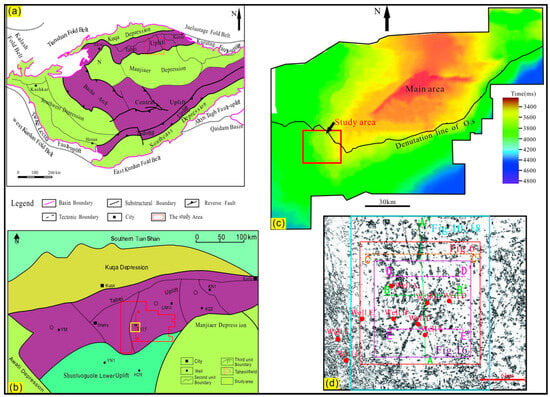
Figure 1.
Location, structural framework, and coherence attributes of the Tahe Oilfield in the Tarim Basin. (a) Tectonic map of the Tarim Basin highlighting the study area on the Tabei Uplift. (b) Secondary structural divisions of the Tabei Uplift. (c) Paleogeomorphologic map of the Upper Ordovician in Tahe. The study area lies in the southern sector where insoluble Upper Ordovician strata are preserved with appreciable thickness. (d) Coherence attribute slice along horizon T74 in the study area.
The types and activity of diagenetic fluids are crucial in affecting dissolution and reforming hydrocarbons []. Additionally, the depth, temperature, and deformation characteristics of strike-slip fault zones significantly impact the migration of oil and gas [], especially in the transition areas between the fault core and damage zones. These factors collectively determine the accumulation and distribution of hydrocarbons. Knowledge of the characteristics of fault-controlled carbonates underpins reliable fracture–cavity identification and the interpretation of sonic logging and seismic information in these reservoirs [].
The genesis and evolutionary history of carbonate reservoirs, especially those hosted in the thick, insoluble southern Tahe formations, are still not well constrained. Ambiguity regarding the roles of Paleozoic strike-slip faults and diagenetic fluids is impeding continued deep exploration and development.
Drawing on core samples, conventional and image logs, and seismic data, this study offers a detailed characterization of fault systems and carbonate reservoir attributes in the deep strata of the southern Tahe Oilfield. Diagenetic fluids are constrained using carbon-, oxygen-, and strontium-isotope analyses together with fluid inclusions. The goals are (1) to clarify the linkage between strike-slip faults and carbonate reservoirs; (2) to identify fluid types, trace their evolution, and evaluate their effects on carbonate dissolution; and (3) to assess the roles of strike-slip faults and diagenetic fluids in reservoir formation and evolution. Addressing these questions provides key guidance for understanding fault–fluid coupling in the deep subsurface.
2. Geological Setting
In the northwest of China, the Tarim Basin encompasses approximately 560,000 km2 []. The basin is a superimposed hydrocarbon-bearing basin bounded by three orogenic belts: Tianshan to the north, Altun to the south, and West Kunlun to the southwest []. Tahe Oilfield, occupying about 2400 km2, is located in the southern sector of the Tabei Uplift within the Tarim Basin (Figure 1a). The Kuqa Depression bounds the Tabei Uplift on the north, with the Manjiaer Depression on its southern side. The structure is an old uplift formed on pre-Sinian metamorphic basement that has been subjected to multiple tectonic episodes. Abundant hydrocarbons occur in Tahe, where Lower–Middle Ordovician carbonates constitute the dominant producing interval, accounting for more than 70% of production. The study area is situated in the field’s south (Figure 1b–d).
Beneath the basin is a pre-Sinian cratonic metamorphic basement, overlain by a sedimentary sequence from the Sinian through the Quaternary with a maximum thickness of 16,000 m []. Marine strata of Paleozoic age occur in the Upper Sinian, Cambrian, and Ordovician, with the Ordovician carbonates constituting the present main producing horizon. In southern Tahe, the Ordovician succession is subdivided into six units from base to top []:
(1) Penglaiba Formation (O1p, Lower Ordovician): thickness 250–400 m, formed in tidal-flat–shallow-shelf environments, and chiefly composed of silty fine-crystalline dolomite with calcareous dolomite.
(2) Lower–Middle Ordovician Yingshan (O1-2y): thickness 600–900 m, restricted–open platform origin, mainly yellowish-gray to light-gray micrite and dolomitic limestone, and conformable on O1p.
(3) Yijianfang Fm. (O2yj, Middle Ordovician): dominated by microcrystalline and sandy limestone from an open-platform setting. The three Upper Ordovician successions are mainly marginal slope–shelf to continental-platform deposits.
(4) O3q Querbake and O3l Lianglitage: principally nodular limestone with muddy/argillaceous limestone.
(5) The Sangtamu Formation (O3s): primarily siliciclastic mudstone and sandstone, as much as 900 m thick, in unconformable contact with the overlying Silurian []. The O3s Formation consists of thick, insoluble siliciclastic rocks and is therefore commonly viewed as a regional caprock that prevents exposure and dissolution of the underlying carbonates. Its pinch-out line partitions the Tahe Oilfield into northern and southern sectors []. The southern region retains a relatively intact Upper Ordovician sequence compared with the north (Figure 2 and Figure 3).
Following development of the pre-Sinian metamorphic basement, the Tabei Uplift experienced multiple major regional tectonic phases—Caledonian, Hercynian, Indosinian–Yanshanian, and Himalayan. Of these, the Middle Caledonian and Early Hercynian events were pivotal for the structural framework and faulting of the Tahe Oilfield. From the Early Sinian to the Early Ordovician, the Tarim block rifted from Rodinia, while the northern Tianshan Ocean expanded north of the Tarim Plate [,]. Middle Caledonian tectonic activity during the Middle Ordovician drove northward motion of the Tarim Plate and its collision with the northern East Tianshan Plate, which shifted the regional stress from tensional to compressional, forming the Tabei Uplift.

Figure 2.
Stratigraphic profiles across the southern Tahe Oilfield. (a) Cross section A–A’, showing a N–S direction. (b). Cross section B–B’, showing a W–E direction. T56, seismic reflector at the top of the Carboniferous Bachu Fm; T70, seismic reflector at the top of the Upper Ordovician Sangtamu Fm; T72, seismic reflector at the top of the Upper Ordovician Lianglitage Fm; T74, seismic reflector at the top of the Middle Ordovician Yijianfang Fm. (main reservoir); T76, seismic reflector at the top of the Middle–Lower Ordovician Yingshan Fm. (main reservoir); T78, seismic reflector at the top of the Lower Ordovician Penglaiba Fm; T80, seismic reflector at the top of the Cambrian (principal source rocks); T90, seismic reflector at the top of the Precambrian.
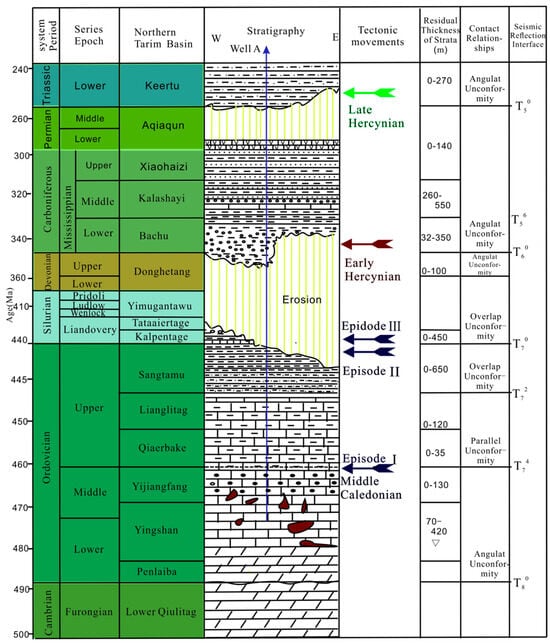
Figure 3.
Generalized stratigraphy of southern Tahe (Upper Cambrian–Lower Triassic) []. T50, reflector marking the Permian top; T56, reflector at the Carboniferous Bachu top; T70, reflector at the Upper Ordovician Sangtamu top; T72, reflector at the Upper Ordovician Lianglitage top; T74, the seismic reflection interface on top of the Middle Ordovician Yijianfang Formation; T80, the seismic reflection interface on top of Cambrian strata.
Middle Caledonian tectonics proceeded in three pulses: the initial pulse barely affected Tabei; the second, due to collision between southern Tarim and the South Kunlun plate, was subdued and uplift persisted; and the third, resulting from collision of the southern Tianshan island arc with Tarim’s northern margin, further elevated northern Tabei and formed the Silurian–Ordovician unconformity [].
At the close of the Devonian, the Early Hercynian event caused severe stripping of the Devonian, Silurian, and Upper Ordovician and generated an angular unconformity between the Carboniferous (C) and Ordovician (O). During the Middle–Late Permian Late Hercynian phase, widespread eruptions and lava effusion occurred across the Tarim Basin, with 10–100 m of Tarim LIP–related magmatic rock intersected in most southern Tahe wells [].
The Tabei Uplift’s differential rise has produced contrasting carbonate reservoir development in the northern versus southern Tahe Oilfield. In the north, multiple tectonic movements removed the Devonian, Silurian, and Upper Ordovician. The Middle and Lower Ordovician (O2yj and O1-2y) carbonate rocks are subaerially exposed and were leached and dissolved by atmospheric fresh water, which developed into a mainly paleokarst drainage system. On the contrary, in the southern Tahe Oilfield, a regional caprock continued to overlie the Middle–Lower Ordovician carbonate section.; hence, these strata did not directly undergo erosion and karstification by atmospheric fresh water. This implies that the southern Tahe oilfield hydrocarbon reservoir development is mainly affected by faults.
3. Data and Methods
3.1. Core Samples, Well Logging, and Seismic Data
In the southern Tahe Oilfield, over 93 wells have been drilled into the Middle–Lower Ordovician carbonates, the majority being vertical with finished depths exceeding 6000 m. Detailed observations were made on cores from 13 coring wells, and 485 core images were gathered to analyze reservoir rock types and characteristics. Over 270 thin sections cut from the carbonate rock cores from 13 representative wells were observed through cathodoluminescence (CL) using a Zeiss Axio Imager fluorescence microscope (Carl Zeiss Microscopy GmbH, Jena, Germany) in the Key Laboratory of Reservoir Geology, in Shandong Province. Obvious differences in the geophysical response between the fracture-cavity and the tight CM were found. Across the study area, 93 suites of conventional logs and 15 FMI records were gathered, yielding sufficient constraints to evaluate fractures and karst features in individual strata.
The study employs a 2013-processed 3D seismic dataset covering about 398 km2, binned at 15 × 15 m; the cube has 2 ms vertical sampling and a target-zone dominant frequency near 35 Hz. The large-scale reservoir shows “a string of beads” strong amplitude in seismic sections []. Seismic processing was completed in multiple stages, and coherence/curvature attributes were computed from the volume across target horizons to recognize and predict faulting and fracturing. Since variance and curvature measure waveform or trace differences in three dimensions, they respond strongly to faults. Areal reservoir distribution was assessed using the amplitude-variation-rate attribute; spatial variation was rendered using a 3D sculpture volume. We used Huygens software (v4.3.1; Scientific Volume Imaging B.V., Hilversum, The Netherland to identify the extent of faults and carbonate caves by characterizing both the spatial distribution pattern of the faults and the spatial morphology of the resulting karst caves. The detailed workflow of this process includes three steps:
- (1)
- Noise filtering and attribute extraction: The SVI software first uses a noise filter to denoise the raw seismic data. The goal of the denoising process is to reduce non-seismic signals caused by seismic instruments, environmental noise, or geological interference, thereby improving the signal-to-noise ratio. SVI applies multiple noise-suppression techniques—e.g., low-pass, high-pass, and time-frequency filters—to attenuate band-limited noise. Following denoising, it derives composite attributes (such as tensor and envelope attributes) from the processed seismic volume. Tensor attributes characterize seismic-wave anisotropy, whereas envelope attributes depict the spatial distribution of signal strength.
- (2)
- Signal enhancement and target recognition: The SVI software enhances the signals of fractures and geological bodies (such as caves and reservoirs). This process strengthens the signal from specific regions in the seismic data (e.g., fracture zones or reservoirs), increasing its contrast with surrounding rock layers to enhance the clarity of the target signal. Common enhancement methods include amplitude adjustment, frequency amplification, and differential processing of local areas. The enhanced signals help highlight the characteristics of fractures and geological bodies, facilitating further target recognition.
- (3)
- Data fusion and visualization: The SVI software fuses the data of identified fractures and geological bodies. This step integrates different data sources (such as spatial coordinates, physical properties, and geometric forms) to construct a comprehensive geological model. The software performs spatial registration, coordinate transformation, and attribute fusion to ensure the compatibility and consistency of different datasets. Through this data fusion, a complete spatial distribution map of fractures and geological bodies can be obtained. Finally, the SVI software uses advanced visualization techniques to display the fused geological data in the form of 3D models or cross-sectional diagrams.
3.2. Geochemistry
The 15 core samples were crushed into millimeter-sized fragments, and pure calcite vein particles were picked out. The pure calcite particles were ground into 200-mesh fine powder for testing by a grinding apparatus. The experimental process is detailed in Han et al. (2019) []. All isotope analyses were performed at the Institute of Geology and Geophysics, Chinese Academy of Sciences. Carbon and oxygen isotopic data are expressed as per mil (‰) δ13C and δ18O relative to the VPDB standard (Pee Dee Belemnite). Analytical precision for both δ13C and δ18O is ±0.2‰.
Twelve powdered samples were analyzed for Sr isotopes on a Finnigan MAT Triton TI. Powders were dissolved in 2 mL of 6 M HCl for 24 h at 100–110 °C. Repeated NBS-987 runs (N = 26) averaged 87Sr/86Sr = 0.710202 ± 0.00004 (2σ), with data normalized to 86Sr/88Sr = 0.1194 [].
We performed FI micro-thermometric work on calcite with a Linkam THMSG600 heating/freezing stage (Linkam Scientific Instruments Ltd., Redhill, United Kingdom). Homogenization temperatures were measured at 10 °C per minute. Altogether, 456 calcite inclusions occupying dissolution pores, fractures, and caverns across 11 wells were analyzed.
4. Results
4.1. Reservoir Types and Characteristics
The Ordovician carbonate reservoirs in southern Tahe were not formed by weathering crust karstification, because the Middle–Lower Ordovician carbonates did not undergo large, prolonged uplift and surface exposure. Over geologic time, these strata experienced complex cementation and sustained strong compaction, so matrix (CM) porosity and permeability contribute very little to reservoir space. Matrix porosity ranges from 0.6 to 3.8% (avg. 1.62%), and permeability is mainly 0.02–21.02 × 10−3 μm2 (avg. 1.32 × 10−3 μm2). In addition, multi-stage tectonism and multi-stage dissolution by diagenetic fluids produced a complex, heterogeneous pore system dominated by dissolved pores, fractures, and caves—the principal reservoir space.
In these Middle–Lower Ordovician reservoirs, dissolved pores are chiefly intergranular, supplemented by intragranular and intercrystalline types, as well as moldic pores (Figure 4a,f). The fluids flowing along the fractures have better contact with surrounding rock on both sides; these fluids dissolve the calcite to form dissolved pores (Figure 4c). The intergranular residual pores and intragranular pores formed by the dissolution of calcite minerals are filled again in the later stage (Figure 4b). The other types of intergranular pores occur between dolomite crystals; dolomite agglomerates are distributed in the stylolite structure, and the intercrystalline pores are filled with asphaltene (Figure 4d,e).
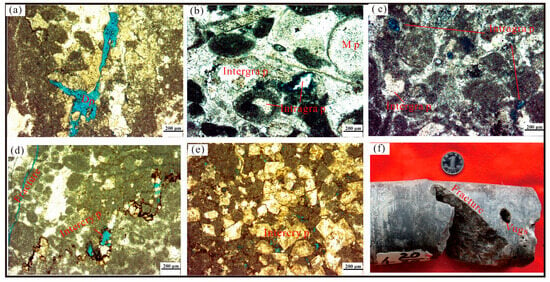
Figure 4.
Photomicrographs and core photos documenting pore and fracture features. (a) Unfilled dissolved pore (Dp) (well A, 6110.43 m, O1-2yj). (b) Moldic pores (Mp), intergranular pore (Intergra p), and intragranular pore (Intragra p) filled with calcite (well A, 6034.51 m, O1-2yj). (c) Unfilled intragranular pore (well A, 6067.31 m, O1-2yj). (d) Microfractures and intercrystalline pores in dolomite along stylolite (well F, 5555.61 m, O1-2yj). (e) Intercrystalline pores in dolomite, unfilled (well G, 5662.23 m, O1-2yj). (f) Dissolution vugs around a fracture (well B, 5895.10 m, O1-2yj).
Fractures are not only an important reservoir space in carbonate rocks, but they also function as a main fluid migration pathway []. Structural fractures constitute a principal reservoir type in the area, occurring mainly along the flanks of fault zones and within fold axes. These are mainly medium-small fractures, wherein small fractures account for 79.7% and medium fractures account for 17.9% of the total fractures (Figure 5a). The low-angle fractures that account for 59.7% are short and flat, and most of them are filled with calcites and clays (Figure 5b,c). The medium-angle and high-angle fractures are tension-shear fractures; their fracture surface is relatively straight, the width of the fracture aperture is more than 0.1–1 cm, and they are unfilled or half-filled with calcites and dark organic matter (Figure 5d). These fractures appear on the FMI as sinusoidal lines, and the amplitudes of sinusoidal lines of fractures with different dip angles are varied. The greater the amplitude of the sinusoidal lines, the larger the fracture dip angle, and vice versa. The faults and derived fractures show good response characteristics on the attribute of maximum negative curvature maps []. The best-developed fractures, appearing as linear/mesh patterns (blue–yellow areas), flank faults on both sides; the bigger the fault, the wider the adjacent fracture belt (Figure 6).
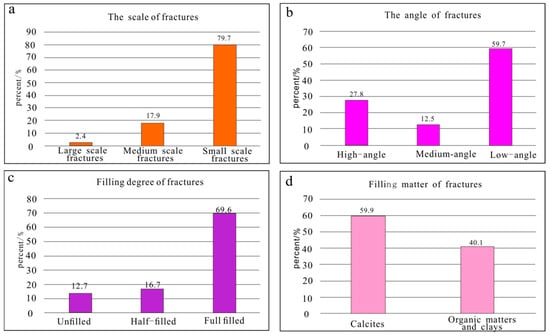
Figure 5.
Fracture information statistics from the cores (N = 768). (a) The size classes of fractures. (b) The dip-angle classes. (c) The degree of filling. (d) The fill materials.

Figure 6.
The attribute of maximum negative curvature along the top of the Middle-Lower Ordovician Yingshan Formation (T76).
The diameter of large caves is more than 100 mm; hence, owing to its large scale, it cannot be completely observed on the core. Karst breccia formed by cave collapse and calcareous debris sediments brought in with flowing water can be observed on the cores. This can be easily identified by dropout, mud loss, and sudden acceleration during drilling. The well logging response of the caves shows that as the natural gamma (GR) value increases, the diameter expands clearly. The deep and shallow induction resistivities (LLD and LLS) drop markedly with a positive separation; density (DEN) also decreases, while sonic travel time (AC) and neutron (CN) increase noticeably. The FMI logs show dark black and disordered images (Figure 7). On the seismic section, owing to the velocity and impedance differences between the caves and surrounding CM, the deep buried cave complexes are displayed as “bright” spot-shaped reflections (Figure 7), suggesting pronounced amplitudes, significant vertical extent, and restricted horizontal range []. This constitutes the principal hydrocarbon storage space and is associated with high well productivity. In this work, we applied the amplitude-variation-rate attribute—highly sensitive to ultra-strong amplitudes—to delineate cave complexes. In homogeneous carbonates, seismic wavelength changes little, whereas encountering caves alters the wavelength and yields high-amplitude, high-frequency responses. Therefore, the amplitude change rate of the CM is a low value and appears as a blue area; in contrast, the fracture cave reservoir development zone shows a high value and displays a bright red color (Figure 8a). The spatial distribution characteristics of cave bodies in carbonate rock can be observed more clearly using 3D models of the caves. The extraction of the enhancement tensor and envelope attributes and carving of the cave body used SVI software, selected appropriate threshold values of the attributes to depict the fracture cavity body, thereby improving our understanding of deeply buried paleokarst reservoirs; the caves are largely isolated spatially and show poor regional connectivity (Figure 8b). The supergene karstification of meteoric water is not developed in the Middle-Lower Ordovician carbonate rocks in this area, and there is no formation of a paleokarst drainage system. Accordingly, reservoir development is largely dictated by the fault architecture.
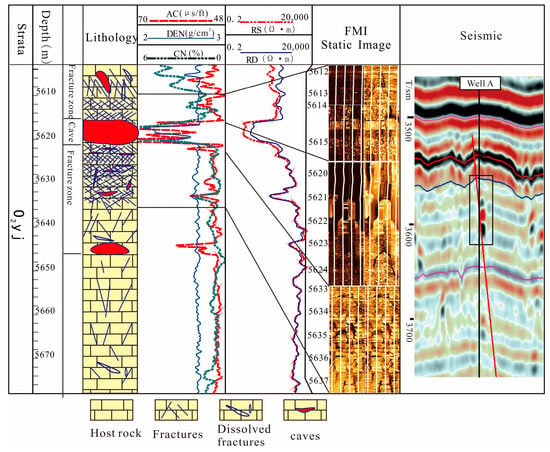
Figure 7.
For well A in the O2yj Formation, the reservoir log response, electrical image log, and seismic expression indicate a fracture–cavity reservoir; the well location is shown in Figure 1d.
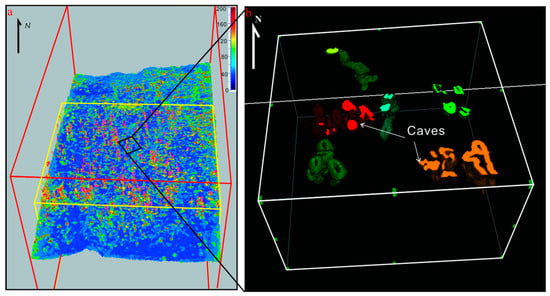
Figure 8.
Derived from a 3D seismic dataset, this is a 3D topographic map of the caves located in the study area. (a) The amplitude change rate showing of fracture cavity. (b) Carving of cave bodies using SVI software.
4.2. Paleozoic Fault Characteristics and Evolution
As the quantitative estimation of the fault formation period is difficult, we primarily determine the relative formation period of the faults within the seismic section. The relationship between faults, neighboring stratigraphy, and unconformity in the seismic section, combined with the analysis of the regional tectonic stress field, allows for the determination of the formation period. When a fault cuts off a stratum, this indicates that the fault is younger than the stratum; conversely, when another fault terminates the stratum, the fault is determined to be older than the stratum [].
4.2.1. Multi-Stages of Paleozoic Faults
Using new 3D seismic data, faults in the study area can be categorized into four stages, based on the fault formation period estimation criteria mentioned above: extensional faults from the Cambrian to Early Ordovician, strike-slip faults in the Middle Ordovician, reactivated strike-slip faults during the Silurian–Devonian, and faults associated with volcanic activities in the Permian.
- (1)
- Extensional normal faults during the Cambrian–Early Ordovician
During the early Caledonian period, the Tarim Basin existed in an extensional setting, which was driven by the spreading of the Ancient Tianshan Ocean, the Ancient Kunlun Ocean, and the Altyn Ocean. The slope area of the Tahe Oilfield within the Tabei Uplift experienced relatively weak north–south extension, leading to the formation of two sets of early normal extensional faults, oriented in the NEE and NWW directions (Figure 9a). The fault plane exhibits a steep and straight form, with throw values that are relatively small; additionally, a portion of this fault plane cuts downward through the top of the Precambrian strata (T90). Under the influence of subsequent multiple-period tectonic movements, the extensional faulting was reactivated and became complex (Figure 10).

Figure 9.
Distribution of the fault system in different stages. (a) Faults formed in the Early Caledonian period. (b) Faults formed in the Middle Caledonian period. (c) Faults formed in the Early Hercynian period. (d) Characteristics of inherited faults.
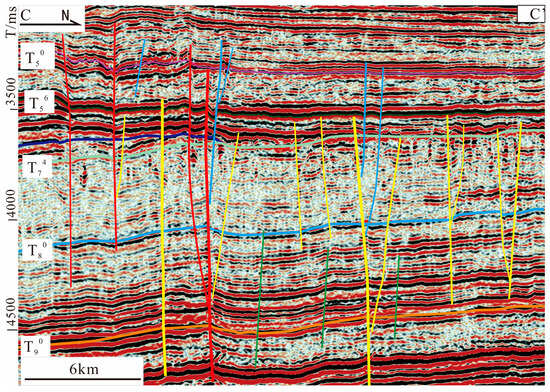
Figure 10.
Across the study area, seismic profiles provide visualizations of Paleozoic faults along with stratigraphic interpretations. See Figure 1, C–C’ for location. Faults are in their color definitions: Early Caledonian in green, Early/Middle Caledonian–Early Hercynian in yellow, Early/Middle Caledonian–Late Hercynian in red, Early Hercynian, and Late Hercynian in navy.
- (2)
- Strike-slip faults in the Middle Ordovician
In the Middle Caledonian, the tectonic stress field of the Tarim Basin changed from extensional to compressional, and the Tahe Oilfield region underwent S–N compression stress action. A group of NNW and NNE trending “X” conjugate shear faults with large extension lengths (Figure 9b) and good continuity can be seen clearly on the stratum coherence attribute map (Figure 11a) and maximum curvature attribute map (Figure 11b). The faults formed during this period are characterized by their large scale as they cut through several strata on the seismic section. The inherited faults also cut through the top surface of the deep Cambrian strata (T90) (Figure 10).
- (3)
- Reactivation of strike-slip faults in the Silurian–Devonian
During the Early Hercynian tectonic movement, the direction of the compressive stress field shifted from S–N to NW–SE. This period represents the most critical stage of tectonic movement for the development of large-scale faults in the Tahe Oilfield. Under the influence of intense tectonic compression-torsion stress, a series of derived faults formed on both sides of the NNW and NNE trending “X”-shaped conjugate strike-slip faults (Figure 9c). Formed in the Middle Caledonian, the faults later moved farther upward and cut through the Upper Ordovician Sangtamu Formation (T70). There are four structural types of strike-slip faults observed on the seismic section: positive flower structures, negative flower structures, and half-flower structures. For the flower structure, the main fault features a steep and straight plane that plunges directly into the deep Cambrian strata. Derived faults lie on both sides of the main fault, converging as they extend from shallow to deep and intersecting with the main fault. Positive flower structures are distinguished by “compression, reverse faults, and anticlinal folds,” whereas negative flower structures are defined by “extension, normal faults, and synclinal structures.” In half-flower structures, derived faults only develop on one side of the main fault (Figure 10).
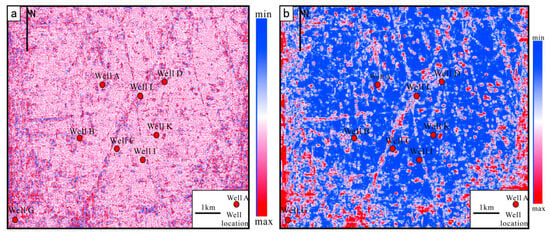
Figure 11.
The curvature attributes of different layer showing different stage faults. (a) Faults originating in the Middle Caledonian period. (b) Faults originating in the Early Hercynian period.
- (4)
- Faults related to volcanic activities during the Permian
By the end of the Early Permian, the Tarim Basin existed in a continental rift extensional setting, driven by the combined effects of the Ancient Tianshan Fold Belt and the subduction of the Old Tethys Ocean. Basic volcanic eruptive rocks and intermediate-acidic eruptive rocks were widely distributed across the Tarim Basin. Volcanic activities during this period led to the formation of a series of extensional normal faults; these faults were mainly distributed along pre-existing faults, with diverse strike directions and relatively short lengths.
4.2.2. Inheritance of Paleozoic Faults
The faults in the study area were comprehensively affected by multi-stage tectonic movements, and the tectonic stress field and evolution characteristics are complex. Therefore, the fault activity may continue over a long period, developing simple to complex evolutionary characteristics, from small to large scales. According to the plane distribution characteristics and evolutionary history of faults on the seismic section, the fault formation and final relative faulting period were determined and analyzed; this is summarized as follows.
- (1)
- From Middle Caledonian to Late Hercynian continual activity
These faults—specifically two groups of NW–SE trending faults with long extensions—are characterized by multi-stage activity and inherited development, often showing as the reactivation of early-formed faults under the influence of late tectonic movements. Along with structural inversion, the nature and scale of the faults usually change. They formed in the Middle Caledonian and ceased activity in the Late Hercynian (Figure 9d), cutting downward through T90 and upward to T50 on the seismic section (Figure 10).
- (2)
- From Middle Caledonian to Early Hercynian continual activity
This area includes faults formed in the Middle Caledonian that stopped activity in the Early Hercynian With the further stress increase, some strike-slip faults were reactivated in the middle Caledonian when the derived strike-slip faults developed on a large scale. These are distributed in the NNW and NNE direction (Figure 9d), cutting downward through T80 and terminating upward at T56 on the seismic section (Figure 10).
- (3)
- Early Hercynian and Late Hercynian active faults
Most of these faults were formed by single-stage tectonic movements, and the later stage tectonic movements had little influence on them. With relatively small scale and short profile extensions, they only cut downward through T74 and terminated upward at T50 (Figure 9).
Owing to the heterogeneity of the tectonic stress field intensity and the transformation of direction of tectonic movements, large-scale strike-slip faults indicate clear segmentation on the plane, with complex differences in the nature, scale, and structural style of the faults.
4.3. Geochemical Characteristics
4.3.1. C and O Isotopes
Carbon and oxygen (C and O) isotopes are capable of reflecting changes in ancient sedimentary environments. Table 1 summarizes the C and O isotopic compositions of samples including carbonate matrix (CM), pore-filling fine-crystalline calcite (PC), fracture-filling middle-coarse crystalline calcite (FC), and cavity-filling coarse crystalline calcite (CC). All samples in this study were collected from the Yingshan Formation and Yijianfang Formation. In marine sedimentary environments, variations in various geological factors are relatively slight; therefore, the chemical and thermodynamic properties of carbonate rocks formed in such environments are relatively stable [].

Table 1.
The isotopic compositions and rare earth elements of calcites in a fissure cave in Tahe Oilfield.
For the CM samples, the δ13C values vary from −1.5‰ to 0.5‰ VPDB, with an average of −0.4‰ VPDB, and the δ18O values range from −6.7‰ to −6.3‰ VPDB, averaging −6.5‰ VPDB (Table 1). Their C and O isotopic compositions match those of Ordovician carbonate rocks that have not been eroded.
For the FC samples, the δ13C values range from −4.67‰ to −0.87‰ VPDB (with an average of −2.47‰ VPDB), and the δ18O values span from −13.3‰ to −7.3‰ VPDB (averaging −9.8‰ VPDB). As for the PC samples, their δ13C values vary between −0.9‰ and 0.72‰ VPDB (average of −6.15‰ VPDB), while their δ18O values range from −6.8‰ to −5.46‰ VPDB (average of −13.08‰ VPDB).
For the CC samples, the δ13C values span from −4.26‰ to −1.50‰ VPDB, with an average of −2.62‰ VPDB, and the δ18O values range from −14.17‰ to −7.96‰ VPDB, averaging −12.65‰ VPDB. In addition to the CM samples, the O and C isotope values of other samples also exhibit an obvious negative offset. The negative δ18O values in calcite are mainly caused by the interference of external fluids during late diagenesis, such as atmospheric fresh water with poor δ18O and hydrothermal fluids with higher temperature causing δ18O values to decrease [,]. The isotopic composition of carbon in CO2 varies depending on fluid sources and forming environments. CO2 derived from mantle magma degassing exhibits δ13C values of −7‰ to −5‰, while that produced by organic matter transformation has δ13C values ranging from −30‰ to −10‰. Additionally, CO2 released from carbonate minerals in clastic sedimentary or argillaceous rocks has δ13C values in the range of −15‰ to −9‰ [].
4.3.2. Sr Isotope
For the CM samples from the Middle-Lower Ordovician, the 87Sr/86Sr ratios range from 0.708741 to 0.708813, with an average of 0.708770 (Table 1). Most of these ratios in the study area fall within the range of Ordovician marine carbonates as defined by Denison []. The PC samples have 87Sr/86Sr ratios spanning 0.708176 to 0.709883 (average of 0.708927); excluding one sample with an exceptionally high value (0.709883), their ratio range is consistent with that of the CM samples. The 87Sr/86Sr ratios of FC and CC samples are 0.709221–0.710177 (average of 0.709601) and 0.709–0.71012 (average of 0.709359), respectively (Figure 12). High 87Sr/86Sr ratios suggest the input of external sources and other fluids rich in 87Sr, such as crust-derived Sr from meteoric freshwater. Additionally, deep intermediate-acid volcanic rocks can also contribute to the increase in 87Sr/86Sr ratios [,,].
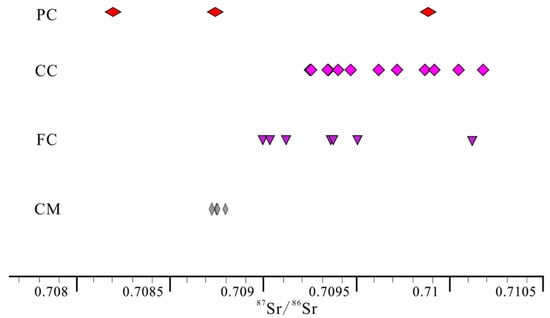
Figure 12.
Strontium isotopic compositions of Ordovician calcite and limestone in the Tahe Oilfield. PC, pore-filling fine-crystalline calcite. CC, cavity-filling coarse crystalline calcite. FC, fracture-filling middle-coarse crystalline calcite. CM, carbonate matrix.
4.3.3. Fluid Inclusions
The formation, development, and evolution of fluids occur alongside the evolution of petroliferous structural basins. The Ordovician reservoir in the Tahe Oilfield is a marine carbonate deposit that has undergone a long-term structural evolution process, enduring multiple tectonic movements and structural deformations. Fluid inclusions in calcite veins from different parts of the Ordovician carbonate strata preserve thermodynamic information—such as temperature and pressure—from various stages throughout the tectonic history. Figure 13 shows the characteristics of homogenization temperatures of fluid inclusions in carbonates in the southern Tahe Oilfield. These homogenization temperatures range from 43.2 °C to 261.3 °C and are divided into three groups according to their distribution: <60–140 °C, 140–170 °C, and 170 °C to over 200 °C.
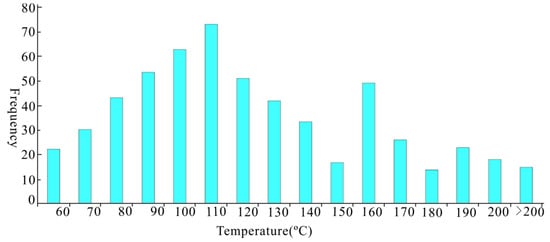
Figure 13.
Statistical analysis of homogenization temperature distribution of calcite saline inclusions.
4.4. Fluids Types and Evolution Constraints According to Petrological and Geochemical Characteristics
In the Tahe Oilfield, the Ordovician carbonate strata feature deep burial and have experienced tectonic movements and fault activities across multiple stages. These thick carbonates have been subjected to transformation by multi-stage fluid dissolution; they have also formed various types and generations of carbonate cements. Optical photomicrographs, CL, and core samples indicate that five generations of cement or fractures/cave-filling calcites formed during burial diagenetic evolutionary history.
The first-stage calcite (C1) was formed in the syngenetic-contemporaneous period. Under the action of atmospheric fresh water, the internal selective dissolution of carbonate rock particles formed mold pores, or intragranular pores filled with calcites (Figure 14a). The second-stage calcite (C2) is generally fine-grained and grows around carbonate particles (Figure 14a,b). The third generation cemented calcite has coarse grains and a rough crystal surface, which is filled in the residual intergranular pores after the formation of the second-generation calcite (Figure 14a,b). The C2 and C3 are mainly formed by burial dissolution and cementation. The fourth-stage calcite (C4) is a clean calcite filled with dissolution pores, showing a bright orange ring under CL. The fifth-stage calcite (C5) is a clean medium coarse crystal calcite with bright orange rings under CL (Figure 14c–f). Both the C4 and C5 are related to hydrothermal fluids.
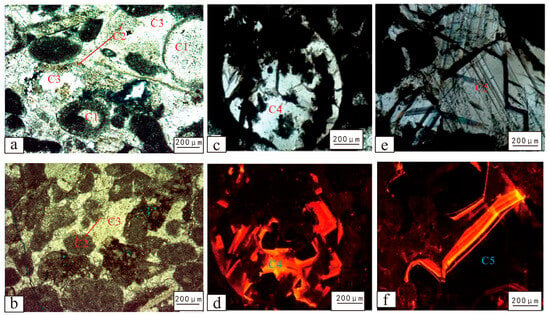
Figure 14.
Photographs displaying five generations of fracture/cave-filling calcites. (a,b) Plane light photomicrographs, showing C1, C2, and C3 calcites in the limestone at depths of 6034.51 m and 6115.53 m in well L. (c,d) Dissolution pores filling with clean C4 calcite and a bright orange band under cathodoluminescence at 5984.12 m in well A. (e,f) C5 calcite with interference fringe, dark inside, and orange band outside on cathodoluminescence at 5972.38 m in well A.
In the three intervals of homogenization temperatures of fluid inclusions (Figure 13), there were three phases of fluids with different temperatures participating in diagenesis. The data support a wide distribution range in the low-temperature section, signifying the homogenization temperature of fluid inclusions within the medium-deep burial diagenetic environment. These diagenetic fluids were mainly atmospheric fresh water and formation fluids. Two abnormal sections of high-temperature data indicate the dissolution of hydrothermal fluids at different temperatures during two separate periods.
The δ18O values of calcite cement in the Middle-Lower Ordovician carbonate rocks in the study area are clearly negative; the minimum value reached 14.17‰ VPDB. The negative δ18O values may be attributed to the meteoric water and deep hydrothermal fluids. When atmospheric fresh water mixes with formation water, the isotopic characteristics of the mixed fluids are between those of atmospheric fresh water and formation water (Figure 15a).
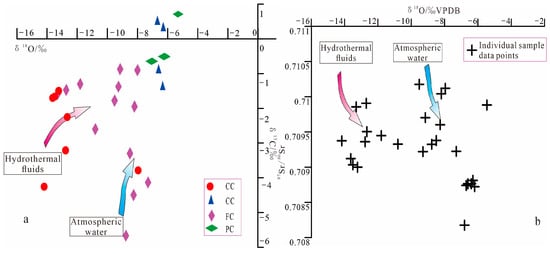
Figure 15.
The δ13C-δ18O (a) and δ18O −87Sr/86Sr (b) relationship of Ordovician calcite in Tahe Oilfield. FC, fracture-filling middle-coarse crystalline calcite; CC, cavity-filling coarse crystalline calcite; PC, pore-filling fine crystalline calcite.
The atmospheric fresh water concentrate large quantities of 87Sr, which seeps into the carbonate rocks along the faults, thus increasing the 87Sr/86Sr value. At the same time, the hydrothermal fluid formed by magmatism also forms calcite veins with high 87Sr/86Sr values (Figure 15b).
5. Discussion
5.1. Diagenesis and Fluid Evolution
Based on petrological observations, fluid inclusion analyses, and isotopic data, the diagenetic processes can be broadly categorized into four stages: penecontemporaneous eogenetic, early mesogenetic diagenetic, hydrothermal diagenetic, and late mesogenetic diagenetic [].
These carbonate strata experienced multiple tectonic uplifting movements and suffered from meteoric freshwater dissolution in the penecontemporaneous eogenetic stage, which occurred during the first episode of the Middle Caledonian and main diagenetic processes and included selective dissolution and calcite cementation []. It can be observed that a large number of intergranular pores and moldic pores are filled with abundant cements (C1).
With the decline of tectonic movement during a stable sedimentary placement period, the study area entered the early mesogenetic diagenesis stage []. The main diagenetic process includes secondary dissolution, pressure solution, recrystallization, compaction, cementation, and filling []. The dissolution of the constructive diagenetic process includes both buried and mixed fluids dissolution. The pores and cavities formed during this period are mostly filled by calcite and other minerals, e.g., C2 and C3. In the middle deep burial stage, the organic matter in the source rock produced acidic fluids rich in organic acids, CO2, and H2S in the mature stage. When the acid fluid is unsaturated to calcium carbonate, it will be extremely corrosive to the carbonate rock []. The δ13C values range from −1.5‰ to 0.72‰ VPDB. The homogenization temperatures of fluid inclusions vary from 60 °C to 90 °C. The dissolution process of mixed fluids is relatively complicated. During the second and third episodes of the Middle Caledonian, as well as the Early Hercynian, numerous large-scale strike-slip faults were formed, and a great number of associated fractures developed around these faults []. These fault systems directly communicated with the surface and had contact with the meteoric freshwater environment. The atmospheric fluids penetrated downward along the fault zone and dissolved the carbonate rock, forming pores and cavities. As the calcium carbonate in the fluid gradually reaches the saturation state, the dissolution weakened. However, when the saturated fluids mixed with formation water, the dissolution occurred again; therefore, the δ18O and δ13C values of calcite cements are between those of meteoric freshwater and formation water, ranging from −10.8‰ to −8.2‰ VPDB and −2.6‰ to −0.87‰ VPDB, respectively (Table 2).

Table 2.
Paragenetic sequence table for the O1-2yj and O1y formations in the southern Tahe Oilfield.
From the Early to Late Permian period, intense magmatic activities occurred in the Tabei Uplift region. High-temperature hydrothermal fluids differentiated from the magma, which was rich in CO2, H2S, SO2, and other volatile substances. The dissolving hydrothermal fluid migrated along the faults to the soluble carbonate rock stratum and flowed laterally along the fractures and within the early dissolution cavities, resulting in different degrees of dissolution on the carbonate rock, leading to the formation of superimposed and transformed pores and caves. Similarly, some minerals such as calcites and hydrothermal products filled in the secondary pores and caves that formed in the early stage (C4 and C5). Minerals associated with hydrothermal activity, such as dolomite, quartz, barite, and fluorite, were precipitated in fractures and dissolution cavities. The δ18O and δ13C values of calcite range from −14.17‰ to −11.8‰ VPDB and −4.67‰ to −1.3‰ VPDB, respectively. The homogenization temperatures of fluid inclusions range from 160 °C to 200 °C. Due to the high temperature of the hydrothermal fluid, when hydrocarbons enter the carbonate strata and oxidation–reduction reactions occur between sulfate and hydrocarbons, thermochemical sulfate reactions (TSRs) take place, generating large quantities of acidic substances such as CO2 and SO2. These acidic substances dissolved in the hydrothermal solution possess extremely strong corrosivity. If these substances continue to move upward, they will further corrode and transform the early dissolution pores.
As the basin entered the stable sedimentary stage, the diagenetic stage evolved into the late mesogenetic diagenesis. During this period, tectonic and TSR dissolution were the main factors that affected the pores, while cementation, compaction, and filling were the main destructive factors.
5.2. Effect of Faults on Carbonate Reservoir Development
Faults are not only the main migration channel of underground fluid but also the main region of carbonate reservoir development [,]. Different faults develop different complex internal structural characteristics within a fault zone []. In turn, fault zones are composed of complex fracture networks, which provide seepage channels for the surface fluids to flow into the deep strata []. Different properties of faults have obvious differences in their control of fracture development. The regions of fault intersection formed multiple groups of fracture systems, which were then affected by multi-stage stress fields. The development of fractures improves the physical properties of carbonate rock for fluid accumulation; hence, the fault intersections are favorable for carbonate hydrocarbon reservoir development. All or most intersections are distributed within fault zones or develop on both sides of fault zones, which indicates that these zones are the most developed for fracture cavities to develop into reservoirs (Figure 16 and Figure 17). Likewise, the fracture cave reservoirs identified via the amplitude change rate attribute map are predominantly distributed on either side of fault zones, at the ends of fault lines, and in the overlapping region between two faults. And the fracture cave reservoirs show a short strip-like distribution along the direction of fault extension (Figure 18).
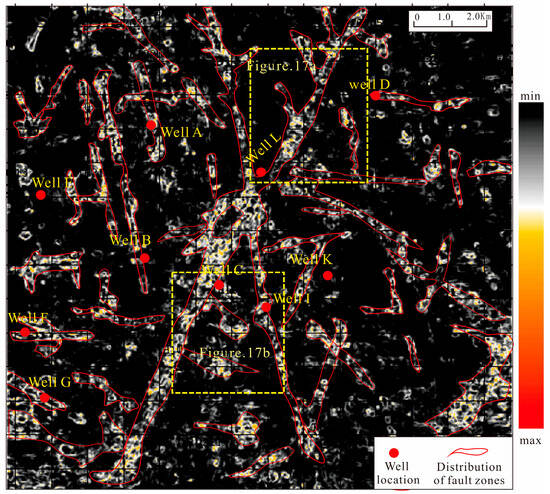
Figure 16.
Fracture zones distribution in of instantaneous phase map.

Figure 17.
Maps of 3D sculpture of fault and cave bodies (a,b).
Faults formed in different active periods have significantly different controlling effects on the distribution of carbonate reservoirs. Fracture cave reservoirs are well-developed near NE- and NW-trending strike-slip faults, where drilling leakage is obvious. The longer the fault activity lasts, the stronger the karstification becomes, and the more corrosive fractures and caves are formed. Therefore, faults formed from the Middle Caledonian to the Late Hercynian have a significantly stronger controlling effect on reservoir distribution and hydrocarbon enrichment (Figure 18). These multi-stage inherited faults clearly controlled the fracture cave reservoirs. Most of the faults that formed in the Middle Caledonian continued to be active during the Early Hercynian and Late Hercynian. Therefore, these faults continued downward into the basement or upward toward the surface, providing pathways for the upward and downward migration of deep hydrothermal fluids or atmospheric fresh water. The fault zones are also where dissolution was strongest, which helped control the development of deep reservoirs.
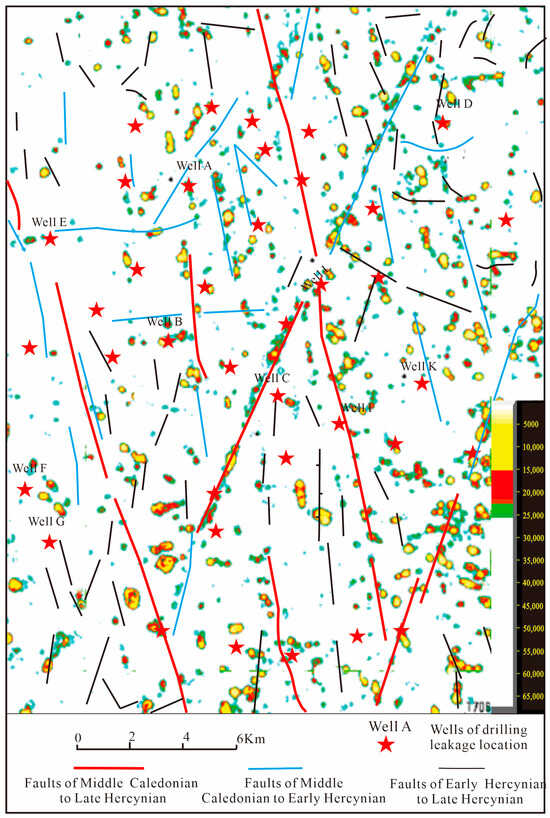
Figure 18.
The congruent map of amplitude change rate attributes and fault systems, showing the fracture cave reservoirs controlled by faults.
5.3. Effect of Strike-Slip Faults and Diagenetic Fluids on the Origin and Evolution of Carbonate Reservoirs
There are several types of dissolution that can occur during a geological period. Dissolution processes during different geological periods transform and overlap with each other, forming complex carbonate reservoirs.
The Early Hercynian is the most critical tectonic movement for the formation and development of fault-controlled carbonate reservoirs in the study area. Driven by NW–SE trending regional stress, the inherited strike-slip faults from the Middle Caledonian became highly active, with both the scale of activity and the width of the fault zones increasing. Meanwhile, a series of faults and folds with NNW, NW, and NE trends were formed. These large-scale strike-slip faults extended upward to the T57 interface and downward to the T90 interface. Faults connecting the surface created long-term conditions for atmospheric freshwater to infiltrate and dissolve the Middle-Lower Ordovician limestone strata along the faults and fracture zones. Additionally, thermochemical sulfate reduction (TSR) occurred in the deep formation, generating substantial amounts of H2S and CO2 during the thermal degradation of organic matter in the strata. The dissolution fluid converges to the fault zone and migrates upward to where fractures and a dissolution vuggy layer formed in the early stage, and dissolution transformation occurred to form new reservoirs. The well-preserved large-scale karst caves, the dissolution vuggy layer, and the fracture reservoir were clearly controlled by faults and were found distributed along the fault zones (Figure 19).
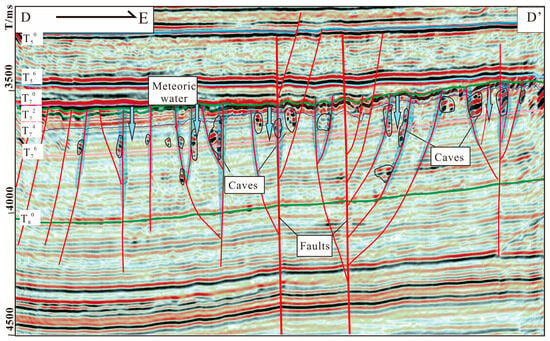
Figure 19.
Seismic profiles across the study area showing the Paleozoic fault and carbonate reservoir development characteristics in the Early Hercynian. See Figure 1, D–D’ for location.
During the Late Hercynian tectonic uplift period at the Permian’s end, a greater number of faults developed, and part of them broke through the surface layer of the Kalashayi Formation. Hydrothermal fluids associated with volcanic activities during this period converged in the fault zone and migrated upward. At the same time, TSR and volcanic activities released a large amount of CO2 and H2S acid gas, which dissolved in the water and contributed to dissolution of the carbonate rock. Meteoric water migrated to these deep strata along the fault zone from the surface, dissolving the carbonate rock and improving its permeability. The mixing of atmospheric fresh water, hydrothermal fluids, and formation water also enhanced the dissolution ability of the fluids. Karstification had the effect of superimposing the dissolution effects on the reservoir formed in the earlier stage, further enlarging the scale of the reservoir, while simultaneously forming some new reservoirs (Figure 20).
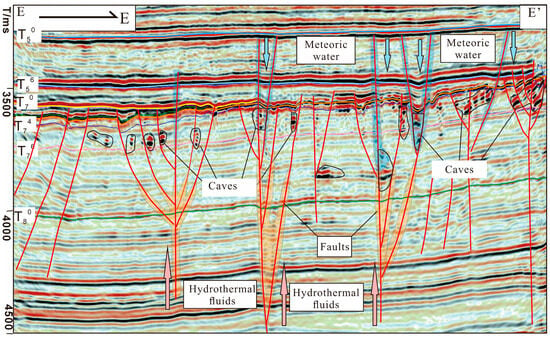
Figure 20.
Seismic profiles across the study area illustrate the development features of Paleozoic faults and carbonate reservoirs in the Late Hercynian. See Figure 1, E–E’ for the profile location. The corresponding strata of each seismic reflection interface are T56 (top of the Carboniferous Bachu Formation), T70 (top of the Upper Ordovician Sangtamu Formation), T72 (top of the Upper Ordovician Lianglitage Formation), T74 (top of the Middle Ordovician Yijianfang Formation, primarily reservoirs), T76 (top of the Middle-Lower Ordovician Yingshan Formation, primarily reservoirs), T78 (top of the Lower Ordovician Penglaiba Formation), T80 (top of Cambrian strata, primarily source rocks), and T90 (top of Precambrian strata).
Based on the tectonic evolutionary history and paragenetic sequence of the O1-2yj and O1y formations in the southern Tahe Oilfield, the following picture emerges. After deposition of the Yijianfang Formation (O1-2yj), a Middle Caledonian uplift accompanied by N–S compression affected the area, during which only small–scale faults and fractures developed in the Tabei sector and reef–shoal bodies were exposed briefly. This interval was dominated by penecontemporaneous meteoric leaching of the carbonates, with no significant compaction, pressure solution, or cementation. During the third Middle Caledonian episode (end of the Sangtamu Formation), persistent N–S compression generated NNW- and NNE-trending strike-slip faults—some inherited—that cut upward through the T70 horizon and downward to T90. Meteoric water percolated along these faults and interacted with formation water to generate organic acids; however, because the uplift–stability interval was short, only a few small, isolated dissolution cavities and fractures formed (Figure 21).
Entering the Early Hercynian, the principal stress shifted to NW–SE, triggering strong reactivation and widening of the earlier strike-slip faults and the development of additional NNW-, NW-, and NE-trending faults and folds. These large faults connected the surface to depth, providing long-lived pathways for meteoric water to penetrate along fault–fracture networks and dissolve Middle–Lower Ordovician limestones. In the deep subsurface, thermal degradation of organic matter released abundant H2S and CO2, initiating thermochemical sulfate reduction (TSR). Dissolution fluids converged within the fault zones and ascended along pre-existing fractures and vugs, overprinting earlier porosity and generating new reservoirs. Permian volcanism further introduced high-temperature hydrothermal fluids, which intensified hydrothermal dissolution while locally producing mineral infill and densification.
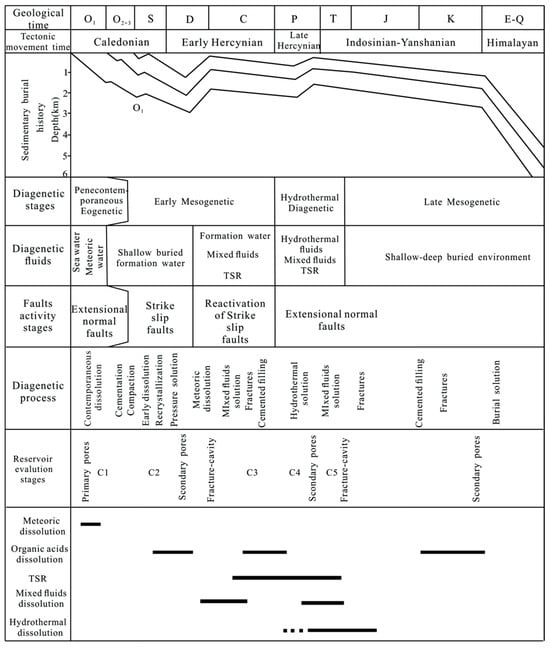
Figure 21.
Burial history and paragenetic sequence of the O1-2yj and O1y Formation in the southern area of Tahe Oilfield.
In terms of diagenetic evolution, meteoric dissolution dominated the penecontemporaneous–early eogenetic stage; during early mesogenesis, secondary dissolution and recrystallization occurred under the influence of burial and mixed fluids (meteoric formation water). Hydrothermal diagenesis was governed by high-temperature hydrothermal fluids, leading to large-scale development of fractures and dissolution pores and the creation of significant reservoir space. In late mesogenesis, pressure solution and cementation prevailed, dissolution waned, and pore space became increasingly filled, restricting reservoir capacity. The time-stratified bars at the base of the figure highlight the staggered and overlapping roles of meteoric water, formation water/organic acid dissolution, TSR, and hydrothermal dissolution across different tectonic and diagenetic stages, collectively shaping a complex carbonate reservoir architecture.
This study establishes the coupling between diagenetic fluids and the staged development of strike-slip faulting, providing a solid basis for advancing the understanding of diagenetic evolution in deep carbonate reservoirs of the Tahe Oilfield and guiding subsequent exploration and development.
6. Conclusions
This study establishes the coupling relationship between diagenetic fluids and the development stages of strike-slip faults. By integrating multiple methods, the following conclusions were drawn:
The Ordovician carbonate reservoirs in the southern Tahe Oilfield can be divided into three types: dissolved pores, fractures, and caves.
These strata have undergone three major geological events: the Middle Caledonian, Early Hercynian, and Late Hercynian tectonic movements, which significantly influenced the development of fracture-vuggy reservoirs. Additionally, the fault systems are divided into four stages: extensional faults during the Cambrian to Early Ordovician, strike-slip faults in the Middle Ordovician, reactivation of strike-slip faults in the Silurian–Devonian, and faults associated with volcanic activity during the Permian.
Four main types of diagenetic fluids—meteoric water, formation water, hydrothermal fluids, and mixed fluids—have played crucial roles in the formation of carbonate reservoirs, with mixed fluids and hydrothermal fluids being particularly influential.
The dissolution of meteoric water is closely linked to two phases of tectonic faulting: the Early Hercynian and the Late Hercynian. The most significant contribution to reservoir development occurred during the Early Hercynian. Hydrothermal dissolution predominantly took place during the large-scale volcanic activities of the Late Hercynian. Thermochemical sulfate reduction (TSR) dissolution occurred primarily between the Early and Late Hercynian, contributing a significant amount of dissolution. Organic acid dissolution within formation water mainly took place during the subsidence and burial stages, particularly during the Late Caledonian, Late Hercynian, and Yanshanian–Himalayan periods.
7. Research Limitations
Although the study utilizes extensive core, well logging, seismic data, and geochemical analysis, the high level of heterogeneity in the carbonate reservoir and the influence of multiple tectonic movements might affect the accuracy and replicability of certain findings in other, less studied areas. These limitations highlight the complexity of deep carbonate reservoir characterization and the need for further data collection to refine the understanding of fault systems and their role in reservoir evolution.
8. Patents
The authors have no patents pending, approved, or issued that are related to this work.
Author Contributions
Conceptualization, Y.W., H.C., Y.L. and S.W.; Data curation, Y.W., H.C., Y.L. and S.W.; Writing—review and editing, Y.W., H.C., Y.L., S.W., Z.L. and Y.M.; Funding acquisition, C.H.; Project administration, C.H.; Methodology, C.H.; Validation, Z.L. and Y.M.; Visualization, Z.L. and Y.M. All authors have read and agreed to the published version of the manuscript.
Funding
This research was funded by the National Natural Science Foundation of China (NSFC, grant no. 42562022); the National Science and Technology Major Project (grant no. 2025ZD1402300); the project “Study on Hydrocarbon Accumulation Rules and Large-Scale Reserve Growth in Marine Facies of the Platform–Basin Area” (grant no. 2025ZD1400506-03); the Sinopec Scientific Research Project “Study on the Fracture–Cavity Structure of the Tahe Reservoir Based on Deep-Burial Modification” (project no. P23034); and the Foundation of Sinopec Key Laboratory of Enhanced Oil Recovery for Fractured Vuggy Reservoirs.
Data Availability Statement
The data supporting the findings of this study are available in the article. Additional raw datasets (e.g., thin-section/CL/SEM images, EPMA and Sr-isotope spreadsheets, fluid-inclusion microthermometric tables, and figure-generating spreadsheets) are available from the corresponding author upon reasonable request and subject to a data-sharing agreement with Sinopec. Seismic and well-log data are proprietary to Sinopec and cannot be shared publicly.
Conflicts of Interest
Author Yan Wang, Huaxin Chen, Yongli Liu, and Shilin Wang are employed by the company Sinopec Northwest Oilfield Company. The remaining authors declare that the research was conducted in the absence of any commercial or financial relationships that could be construed as a potential conflict of interest. The authors declare no conflict of interest.
References
- Zenger, D.H.; Junham, J.B.; Ethington, R.L. Concepts and Models of Dolomitization; SEPM Special Publication; SEPM Society for Sedimentary Geology: Tulsa, OK, USA, 1980; Volume 28, p. 320. [Google Scholar]
- Pang, X.Q.; Jia, C.Z.; Pang, H.; Yang, H.J. Destruction of hydrocarbon reservoirs due to tectonic modifications: Conceptual models and quantitative evaluation on the Tarim Basin, China. Mar. Pet. Geol. 2018, 91, 401–421. [Google Scholar] [CrossRef]
- Yousufia, M.M.; Elhaja, M.E.M.; Moniruzzamanb, M.; Abdalla, M. A review on use of emulsified acids for matrix acidizing in carbonate reservoirs. Int. J. Appl. Eng. Res. 2018, 13, 8151–8164. [Google Scholar] [CrossRef]
- He, Z.L.; Zhang, J.T.; Ding, Q.; You, D.H.; Peng, S.T.; Zhu, D.Y.; Qian, Y.X. Factors controlling the formation of high-quality deep to ultra-deep carbonate reservoirs. Oil Gas Geol. 2017, 38, 633–644. [Google Scholar]
- Ma, Y.S.; He, Z.L.; Zhao, P.R.; Zhu, H.Q.; Han, J.; You, D.H.; Zhang, J.T. A new progress in formation mechanism of deep and ultra-deep carbonate reservoir. Acta Pet. Sin. 2019, 40, 1415–1425. [Google Scholar]
- IHS. Energy-World [EB/OL]. Houston, Texas: IHS; 2014-09-01. Available online: https://www.ihs.com/Info/ecc/a/new-energy-world.html (accessed on 1 September 2014).
- Yun, L.; Zhai, X.X. Discussion on characteristics of the Cambrianreservoirs and hydrocarbon accumulation in Well Tashen 1, Tarim Basin. Oil Gas Geol. 2008, 29, 726–732. [Google Scholar]
- Zhu, D.; Meng, Q.; Jin, Z.; Liu, Q.; Hu, W. Formation mechanism of deep Cambrian dolomite reservoirs in the Tarim Basin, northwestern China. Mar. Pet. Geol. 2015, 59, 232–244. [Google Scholar] [CrossRef]
- Zhu, G.Y.; Zou, C.N.; Yang, H.J.; Wang, K.; Zheng, D.M.; Zhu, Y.F.; Wang, Y. Hydrocarbon accumulation mechanisms and industrial exploration depth of large-area fracture–cavity carbonates in the Tarim Basin, western China. Mar. Pet. Geol. 2015, 133, 889–907. [Google Scholar] [CrossRef]
- Wu, G.H.; Zhao, K.Z.; Qu, H.Z.; Nicola, S.; Zhang, Y.T.; Han, J.F.; Xu, Y.F. Permeability distribution and scaling in multi-stages carbonate damage zones: Insight from strike-slip fault zones in the Tarim Basin, NW China. Mar. Pet. Geology. 2020, 114, 104208. [Google Scholar] [CrossRef]
- Lan, X.D.; Lü, X.X.; Zhu, Y.M.; Yu, H.F. The geometry and origin of strike-slip faults cutting the Tazhong low rise megaanticline (central uplift, Tarim Basin, China) and their control on hydrocarbon distribution in carbonate reservoirs. Mar. Pet. Geol. 2015, 22, 633–645. [Google Scholar] [CrossRef]
- Hendrix, M.S.; Brassell, A.C.; Carroll, A.R.; Graham, S.A. Sedimentology, organic geochemistry, and petroleum potential of Jurassic coal measures: Tarim, Junggar, and Turpan basins, northwest China. AAPG Bull. 1995, 79, 929–959. [Google Scholar] [CrossRef]
- Jin, Z.J.; Zhu, D.Y.; Hu, W.X.; Zhang, X.F.; Zhang, J.T.; Song, Y.C. Mesogenetic dissolution of the middle Ordovician limestone in the Tahe oilfield of Tarim basin, NW China. Mar. Pet. Geol. 2009, 26, 753–763. [Google Scholar] [CrossRef]
- Han, C.C.; Lin, C.Y.; Lu, X.B.; Tian, J.J.; Ren, L.H.; Ma, C.F. Petrological and geochemical constraints on fluid types and formation mechanisms of the Ordovician carbonate reservoirs in Tahe Oilfield, Tarim Basin, NW China. J. Pet. Sci. Eng. 2019, 178, 106–120. [Google Scholar] [CrossRef]
- Ye, N.; Zhang, S.N.; Qing, H.R.; Lie, Y.T.; Huang, Q.Y.; Liu, D. Dolomitization and its impact on porosity development and preservation in the deeply burial Lower Ordovician carbonate rocks of Tarim Basin, NW China. J. Pet. Sci. Eng. 2019, 182, 106303. [Google Scholar] [CrossRef]
- Loucks, R.G.; Mescher, P.K.; McMechan, G.A. Three-dimensional architecture of a coalesced, collapsed paleocave system in the Lower Ordovician Ellenburger Group, central Texas. AAPG Bull. 2004, 88, 545–564. [Google Scholar] [CrossRef]
- Zeng, H.; Loucks, R.; Janson, X.; Wang, G.; Xia, Y.; Yuan, B.; Xu, L. Three dimensional seismic geomorphology and analysis of the Ordovician paleokarst drainage system in the central Tabei Uplift, northern Tarim Basin, western China. AAPG Bull. 2011, 95, 2061–2083. [Google Scholar] [CrossRef]
- Zeng, H.; Wang, G.; Janson, X.; Loucks, R.; Xia, Y.; Xu, L.; Yuan, B. Characterizing seismic bright spots in deeply buried, ordovician paleokarst strata, Central tabei uplift, tarim Basin, western China. Geophysics 2011, 76, 127–137. [Google Scholar] [CrossRef]
- Yuan, S.X.; Jia, C.Z.; Gao, R.S. Sedimentation characteristics and reservoir geological model of Mid -Lower Ordovician carbonate rock in Tazhong northern slope. Acta Pet. Sin. 2012, 33 (Suppl. S1), 80–88. [Google Scholar]
- Yang, H.; Zhu, G.; Wang, Y.; Su, J.; Zhang, B. The geological characteristics of reservoirs and major controlling factors of hydrocarbon accumulation in the Ordovician of Tazhong area, Tarim Basin. Energy Explor. Exploit. 2014, 32, 345–368. [Google Scholar] [CrossRef]
- Tian, F.; Jin, Q.; Lu, X.; Lei, Y.; Zhang, L.; Zheng, S.; Liu, N. Multi-layered Ordovician paleokarst reservoir detection and spatial delineation: A case study in the Tahe Oilfield, Tarim Basin, Western China. Mar. Pet. Geol. 2016, 69, 53–73. [Google Scholar] [CrossRef]
- Tian, F.; Lu, X.; Zheng, S.; Zhang, H.; Rong, Y.; Yang, D.; Liu, N. Structure and filling characteristics of paleokarst reservoirs in the northern Tarim Basin, revealed by outcrop, core and borehole images. Open Geosci. 2017, 9, 266–280. [Google Scholar] [CrossRef]
- Lu, X.B.; Wang, Y.; Tian, F.; Li, X.; Yang, D.; Li, T.; He, X. New insights into the carbonate karstic fault system and reservoir formation in the Southern Tahe area of the Tarim Basin. Mar. Pet. Geol. 2017, 86, 587–605. [Google Scholar] [CrossRef]
- Tian, F.; Luo, X.R.; Zhang, W. Integrated geological-geophysical characterizations of deeply buried fractured-vuggy carbonate reservoirs in Ordovician strata, Tarim Basin. Mar. Pet. Geol. 2019, 99, 292–309. [Google Scholar] [CrossRef]
- Wu, G.H.; Yang, H.J.; He, S.; Cao, S.J.; Liu, X.; Jing, B. Effects of structural segmentation and faulting on carbonate reservoir properties: A case study from the Central Uplift of the Tarim Basin, China. Mar. Pet. Geol. 2016, 71, 183–197. [Google Scholar] [CrossRef]
- Li, Y.; Xue, Z.J.; Cheng, Z.; Jiang, H.J.; Wang, R.Y. Progress and development directions of deep oil and gas exploration and development in China. China Pet. Explor. 2020, 25, 43–57. [Google Scholar]
- Lu, X.B.; Hu, W.G.; Wang, Y.; Li, X.H.; Li, T.; Lv, Y.P.; He, X.M.; Yang, D.B. Characteristics and development practice of fault-karst carbonate reservoirs in Tahe area, Tarim Basin. Oil Gas Geol. 2015, 36, 347–354. [Google Scholar]
- Dong, S.; Li, Z.; Jiang, L. The ordovicianesilurian tectonic evolution of the northeastern margin of the tarim block, NW China: Constraints from detrital zircon geochronological records. J. Asian Earth Sci. 2016, 122, 1–19. [Google Scholar] [CrossRef]
- Lu, Z.Y.; Chen, H.H.; Qing, H.R.; Chi, G.X.; Chen, Q.L.; You, D.H.; Yin, H.; Zhang, S.Y. Petrography, fluid inclusion and isotope studies in Ordovician carbonate reservoirs in the Shunnan area, Tarim basin, NW China: Implications for the nature and timing of silicification. Sediment. Geol. 2017, 359, 29–43. [Google Scholar] [CrossRef]
- Kim, Y.S.; Sanderson, D.J. Structural similarity and variety at the tips in a wide range of strike–slip faults: A review. Terra Nova 2006, 18, 330–344. [Google Scholar] [CrossRef]
- Aydin, A.; Berryman, J.G. Analysis of the growth of strike-slip faults using effective medium theory. J. Struct. Geol. 2010, 32, 1629–1642. [Google Scholar] [CrossRef]
- Storti, F.; Billi, A.; Salvini, F. Particle size distribution in natural carbonate fault rocks: Insights for non-self similar cataclasis. Earth Planet. Sci. Lett. 2003, 206, 173–186. [Google Scholar] [CrossRef]
- Micarelli, L.; Benedicto, A.; Wibberley, C.A.J. Structural evolution and permeability of normal fault zones in highly porous carbonate rocks. J. Struct. Geol. 2006, 28, 1214–1227. [Google Scholar] [CrossRef]
- Agosta, F.; Prasad, M.; Aydin, A. Physical properties of carbonate fault rocks, Fucino basin (Central Italy): Implications for fault seal in platform carbonates. Geofluids 2007, 7, 19–32. [Google Scholar] [CrossRef]
- Childs, C.; Manzocchi, T.; Walsh, J.J.; Bonson, C.G.; Nicol, A.; Schöpfer, M.P.J. A geometric model of fault zone and fault rock thickness variations. J. Struct. Geol. 2009, 31, 117–127. [Google Scholar] [CrossRef]
- Choi, J.H.; Edwards, P.; Ko, K.; Kim, Y.S. Definition and classification of fault damage zones: A review and a new methodological approach. Earth-Sci. Rev. 2016, 152, 70–87. [Google Scholar] [CrossRef]
- Agosta, F. Fluid flow properties of basin-bounding normal faults in platform carbonates, Fucino Basin, central Italy. In the Internal Structure of Fault Zones: Implications for Mechanical and Fluid-flow Properties; Wibberley, C.A.J., Kurz, W., Imber, J., Holdsworth, R.E., Collettini, C., Eds.; Special Publications; Geological Society: London, UK, 2008; Volume 299, pp. 277–291. [Google Scholar]
- Williams, R.T.; Goodwin, L.B.; Mozley, P.S. Diagenetic controls on the evolution of fault-zone architecture and permeability structure: Implications for episodicity of fault-zone fluid transport in extensional basins. GSA Bull. 2017, 129, 464–478. [Google Scholar] [CrossRef]
- Jia, L.Q. Sulfur isotopic compositions of individual organosulfur compounds and their genetic links in the Lower Paleozoic petroleum pools of the Tarim Basin, NW China. Geochim. Cosmochim. Acta 2016, 182, 88–108. [Google Scholar]
- Yuan, F.; Tian, J.; Hao, F.; Liu, Z.; Zhang, K.; Wang, X. Fault characterization and its significance on hydrocarbon migration and accumulation of western Tazhong Uplift, Tarim Basin: Insight from seismic, geochemistry, fluid inclusion and in situ U-Pb dating. Mar. Pet. Geol. 2024, 170, 107137. [Google Scholar] [CrossRef]
- Gong, F.; Song, Y.; Zeng, L.; Peng, S.; Zou, G.; Wang, G. Effect of fluid saturation on the elastic properties of carbonate rocks with different pore structures in a strike-slip fault zone. Geoenergy Sci. Eng. 2025, 255, 214110. [Google Scholar] [CrossRef]
- Yu, J.B.; Li, Z.; Yang, L. Fault system impact on paleokarst distribution in the Ordovician Yingshan Formation in the central Tarim basin, northwest China. Mar. Pet. Geol. 2016, 75, 105–118. [Google Scholar] [CrossRef]
- Li, C.X.; Wang, X.F.; Li, B.L.; He, D.F. Paleozoic fault systems of the Tazhong Uplift, Tarim Basin, China. Mar. Pet. Geol. 2013, 39, 48–58. [Google Scholar] [CrossRef]
- Zhu, G.Y.; Zhang, Z.Y.; Zhou, X.X.; Lia, T.T.; Han, J.F.; Sun, C.H. The complexity, secondary geochemical process, genetic mechanism and distribution prediction of deep marine oil and gas in the Tarim Basin, China. Earth-Sci. Rev. 2019, 39, 48–58. [Google Scholar] [CrossRef]
- Tian, F.; Di, Q.Y.; Jin, Q.; Cheng, F.Q.; Zhang, W.; Lin, L.M.; Wang, Y.; Yang, D.B.; Niu, C.K.; Li, Y.X. Multiscale geological-geophysical characterization of the epigenic origin and deeply buried paleokarst system in Tahe Oilfield, Tarim Basin. Mar. Pet. Geol. 2019, 102, 16–32. [Google Scholar] [CrossRef]
- Xu, B.; Jian, P.; Zheng, H.F.; Zou, H.B.; Zhang, L.F.; Liu, D.Y. U-Pb zircon geochronology and geochemistry of Neoproterozoic volcanic rocks in the Tarim Block of northwest China: Implications for the breakup of Rodinia supercontinent and Neoproterozoic glaciations. Precambrian Res. 2005, 136, 107–123. [Google Scholar] [CrossRef]
- Wu, G.H.; Sun, J.H.; Guo, Q.Y.; Tang, T.; Chen, Z.Y.; Feng, X.J. The distribution of detrital zircon UePb ages and its significance to Precambrian basement in Tarim Basin. Acta Geosci. Sin. 2010, 31, 64–72, (In Chinese with abstract). [Google Scholar]
- Xu, K.; Yu, B.S.; Gong, H.N.; Ruan, Z.; Pan, Y.L.; Ren, Y. Carbonate reservoirs modified by magmatic intrusions in the Bachu area, Tarim Basin, NW China. Mar. Pet. Geol. 2015, 6, 779–790. [Google Scholar] [CrossRef]
- Ding, W.L.; Fan, T.L.; Yu, B.S.; Huang, X.B.; Liu, C. Ordovician carbonate reservoir fracture characteristics and fracture distribution forecasting in the Tazhong area of Tarim Basin, Northwest China. J. Pet. Sci. Eng. 2012, 86–87, 62–70. [Google Scholar] [CrossRef]
- Denison, R.E.; Koepnick, R.B.; Burke, W.H.; Hetherington, E.A. Construction of the Cambrian and Ordovician seawater 87Sr/86Sr curve. Chem. Geol. 1998, 152, 325–340. [Google Scholar] [CrossRef]
- Han, C.C.; Tian, J.J.; Hu, C.L.; Liu, H.L.; Wang, W.F.; Huan, Z.P.; Feng, S. Lithofacies characteristics and their controlling effects on reservoirs in buried hills of metamorphic rocks: A case study of late Paleozoic units in the Aryskum depression, South Turgay Basin, Kazakhstan. J. Pet. Sci. Eng. 2020, 191, 107–137. [Google Scholar] [CrossRef]
- Ngong, R.N.; Hu, M.Y.; Gao, D. Tectonic and geothermal controls on dolomitization and dolomitizing fluid flows in the Cambrian-Lower Ordovician carbonate successions in the western and central Tarim basin, NW China. J. Asian Earth Sci. 2019, 172, 359–382. [Google Scholar] [CrossRef]
- Wu, J.; Fan, T.L.; Gao, Z.Q.; Yin, X.X.; Fan, X.; Li, C.C.; Yue, W.Y.; Lia, C.; Zhang, C.J.; Zhang, J.H.; et al. A conceptual model to investigate the impact of diagenesis and residual bitumen on the characteristics of Ordovician carbonate cap rock from Tarim Basin, China. J. Pet. Sci. Eng. 2018, 168, 226–245. [Google Scholar] [CrossRef]
- Li, P.P.; Hao, F.; Zhang, B.Q.; Zou, H.Y.; Yu, X.Y.; Wang, G.W. Heterogeneous distribution of pyrobitumen attributable to oil cracking and its effect on carbonate reservoirs: Feixianguan Formation in the Jiannan gas field, China. AAPG Bull. 2015, 99, 763–789. [Google Scholar] [CrossRef]
- Chen, L.; Kang, Z.H.; Li, P.; Rong, Y.M.; Dai, H.B. Development characteristics and geological model of Ordovician karst carbonate reservoir space in Tahe oilfield. Geoscience 2013, 27, 356–365. [Google Scholar]
- Woodcock, N.H.; Sayers, N.J.; Dickson, J.A. Fluid flow history from damage zone cements near the dent and Rawthey faults, NW England. J. Geol. Soc. 2008, 165, 829–837. [Google Scholar] [CrossRef]
- Richey, D.; Evans, J.P. Fault architecture, linkage and internal structure: Field examples from the iron wash fault zone, central Utah. Gulf Coast Assoc. Geol. Soc. 2013, 42, 91–112. [Google Scholar]
- Bonson, C.G.; Childs, C.; Walsh, J.J.; SchPfer, M.P.J.; Carboni, V. Geometric and kinematic controls on the internal structure of a large normal fault in massive limestones: The maghlaq fault, malta. J. Struct. Geol. 2007, 29, 336–354. [Google Scholar] [CrossRef]
Disclaimer/Publisher’s Note: The statements, opinions and data contained in all publications are solely those of the individual author(s) and contributor(s) and not of MDPI and/or the editor(s). MDPI and/or the editor(s) disclaim responsibility for any injury to people or property resulting from any ideas, methods, instructions or products referred to in the content. |
© 2025 by the authors. Licensee MDPI, Basel, Switzerland. This article is an open access article distributed under the terms and conditions of the Creative Commons Attribution (CC BY) license (https://creativecommons.org/licenses/by/4.0/).